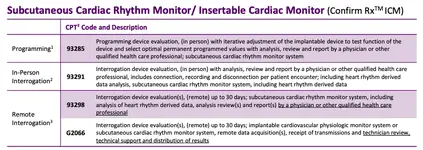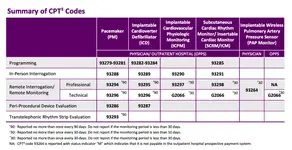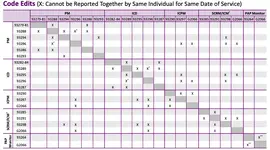Effective January 1, 2020, the technical CPT code for remote monitoring of implantable loop recorders has changed from CPT 93299 to CPT G2066. This code is carrier based and should be used for all remote monitoring sessions that are billed after January 1, 2020.
The review and professional interpretation of all transmissions of an implantable loop recorder
for each 30 day period should be billed under CPT 93298.
CPT 93298. Interrogation device evaluation(s), (remote) up to 30 days; subcutaneous cardiac rhythm monitor system, including analysis of recorded heart rhythm data, analysis, review(s) and report(s) by a physician or other qualified healthcare professional. The professional interpretation CPT code for the remote monitoring of an implantable loop recorder should be billed
once for each 30 day period (on day 31). The professional code should be billed in conjunction with the appropriate remote monitoring technical code (CPT G2066)
CPT G2066 Interrogation device evaluation(s), (remote) up to 30 days; implantable cardiovascular physiologic monitor system or subcutaneous cardiac rhythm monitor system, remote data acquisition(s), receipt of transmissions and technician review, technical support and distribution of results. The technical remote monitoring CPT code for implantable loop recorders should be billed
for each 30-day period (on day 31). On average, this test should be billed 12 times per year.
Based on Heart Rhythm Society and manufacturer guidelines, all implantable loop recorders must be monitored continuously and a review of all transmissions must be done at least one time per 30-day period (12 times per year.) While these devices may automatically trigger many times per month, both the technical and professional CPT codes are only billed
once per 30-day period (day 31).
For each 30-day period, CPT 93298 (professional review and interpretation) and CPT G2066 (technical monitoring)
should be billed on day 31.
The code previously used to report the technical portion of remote monitoring (CPT‡ code 93299) applies to claims with a date of service on or before December 31, 2019. The new code (G2066) applies to claims with a date of service on or after January 1, 2020.
Billing and Coding: Cardiac Rhythm Device Evaluation
Revision Effective Date
10/01/2022
01/01/2020 The following CPT/HCPCS code has been deleted: 93299. The statements referencing 93264 and 93297 - 93299 have been removed from the article text. References to these codes in this article was a clerical error. The codes are not addressed in this article.
https://www.cms.gov/medicare-coverage-database/view/article.aspx?articleId=56602
REMOTE INTERROGATION
If the healthcare provider downloads or reviews data multiple times
during the remote interrogation period, can he/she report the
applicable code(s) multiple times?
No, according to CPT‡ guidelines, the remote interrogation codes may
only be reported once per 90 days for pacemakers/ICDs/CRT and once
per 30 days for Implantable Cardiovascular Physiologic Monitors,
Subcutaneous Cardiac Rhythm Monitors and Implantable Wireless
Pulmonary Artery Sensors.7 This applies to both the professional and
technical remote interrogation codes.
Can the physician report both the professional and technical codes
for remote interrogation if a device industry representative is
involved in performing the technical service, under the physician’s
direction?
No. If a device industry representative is involved in performing the
technical service under the physician’s direction, then the physician
may NOT bill for the technical service and may only bill the
professional services that are actually performed by the physician, i.e.,
physician analysis, review(s) and report(s).
Do the technical component codes require that the physician/facility
own the device interrogation and programming equipment?
No. There is no reference to equipment ownership as a
requirement for billing the technical component codes.
How is the new code (G2066) different from the old code
(93299)?
The new code (G2066) is a Level II HCPCS G-code, whereas the old
code (93299) was a CPT‡ code. Level II HCPCS G-codes are
temporary national codes for items and services that require
uniform national coding but do not have a corresponding CPT‡
code.14 These codes remain active until they are converted into
permanent codes or until Medicare notifies contractors to delete
them. G-codes are created by Medicare for Medicare use, but they
may also be used by some commercial payers.










